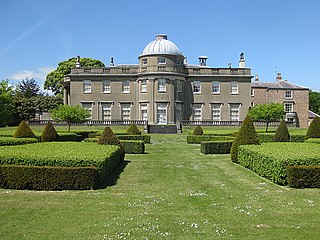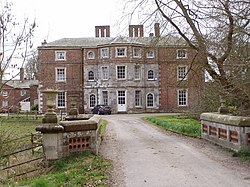
Scampston Hall is a Grade II* listed country house in North Yorkshire, England, with a serpentine park designed by Charles Bridgeman and Capability Brown. It is located on the north side of the A64 Leeds/Scarborough road, 4 miles (6 km) east of Malton, in Scampston village. The name of the village was referred to in various ways in ancient documents as: Scamestun, Skameston, Skameston, and Skampston, and was probably derived from a personal name.

Hovingham Hall is a country house built in the Palladian style in the village of Hovingham, North Yorkshire, England. It has been the seat of the Worsley family and the childhood home of the Duchess of Kent. It was built in the 18th century on a site the Worsleys have occupied since the 16th century.

Boynton is a village and civil parish in the East Riding of Yorkshire, England. It is approximately 3 miles (5 km) west of the town of Bridlington and lies on the B1253 road.

Marske Hall is a 17th-century former mansion house, now a Valorum Care Group residential care home, in Marske-by-the-Sea, Redcar and Cleveland, England. It has Grade I listed building status.

Burton Agnes Hall is an Elizabethan manor house in the village of Burton Agnes, near Driffield in the East Riding of Yorkshire, England. It was built by Sir Henry Griffith in 1601–10 to designs attributed to Robert Smythson. The older Norman Burton Agnes Manor House, originally built in 1173, still stands on an adjacent site; both buildings are now Grade I listed buildings.

The Strickland, later Cholmley, later Strickland-Constable Baronetcy, of Boynton in the County of York, is a title in the Baronetage of England. It was created on 30 July 1641 for the politician William Strickland.

Sir William Strickland, 1st Baronet was an English Member of Parliament who supported the parliamentary cause during the English Civil War.

Sir George Strickland, 7th Baronet, also known as Sir George Cholmley was an English Member of Parliament and lawyer. He took the name Cholmley to succeed to the Cholmley estates in 1865.

Sir William Strickland, 4th Baronet, of Boynton, East Riding of Yorkshire, was an English landowner and Whig politician, who sat in the House of Commons from 1708 to 1735. He was a Government Minister in Sir Robert Walpole's administration.

Sir Thomas Strickland, 2nd Baronet was an English politician who sat in the House of Commons in 1659.

Ripley Castle is a Grade I listed 14th-century country house in Ripley, North Yorkshire, England, 3 miles (4.8 km) north of Harrogate.

Ribston Hall is a privately owned 17th-century country mansion situated on the banks of the River Nidd, at Great Ribston, near Knaresborough, North Yorkshire, England. It is a Grade II* listed building.

Healaugh Park Priory was an Augustinian priory in Healaugh, North Yorkshire, England, some 2 miles (3 km) north of Tadcaster.

Boughton Monchelsea Place, previously Boughton Court, is a 16th-century country house in Boughton Monchelsea, Kent, England. The first part of the house was built by Robert Rudston circa 1567–75 on the site of an earlier manor house. It has been modified a number of times during its history achieving its present form in 1819. It has been a home to a number of members of parliament for Maidstone or for Kent, including Sir Francis Barnham, Sir Robert Barnham (1646–85) Sir Barnham Rider (1698–1728) and Thomas Rider (1805–47).

The Palmes family of Naburn Hall, and the cadet branches of Lindley Hall, North Yorkshire; Ashwell, Rutland; and Carcraig in Ireland, are an ancient English aristocratic family, noted for their adherence to Catholicism.

Forcett Hall is an English country house in the village of Forcett, North Yorkshire, England, some 6.5 miles (10 km) west of Darlington. It is a Grade I listed building.

Dalton Hall is a grade II* listed Georgian country house in Dalton Holme, East Riding of Yorkshire, England.

Walcot Hall is a Grade I listed Carolean country house in the civil parish of Southorpe, Cambridgeshire, England. It lies 2 km south east of the village of Barnack. The house is now within the boundary of the Peterborough unitary authority area of the ceremonial county of Cambridgeshire but it was part of the Soke of Peterborough, an historic area that was traditionally associated with Northamptonshire.

Earsham House is a Georgian country house near the village of Earsham, Norfolk. It is a Grade II* listed building.

Byram Park is a former country estate in Byram, North Yorkshire, a village in England.




















